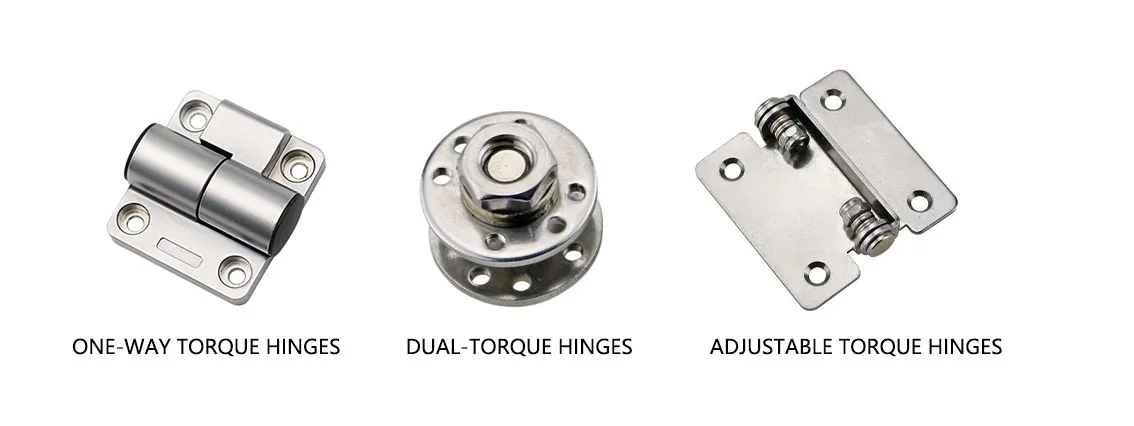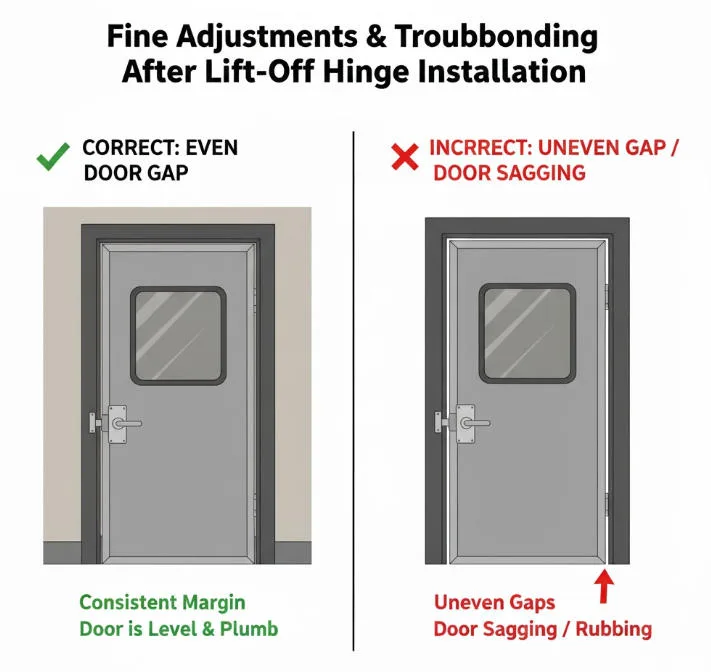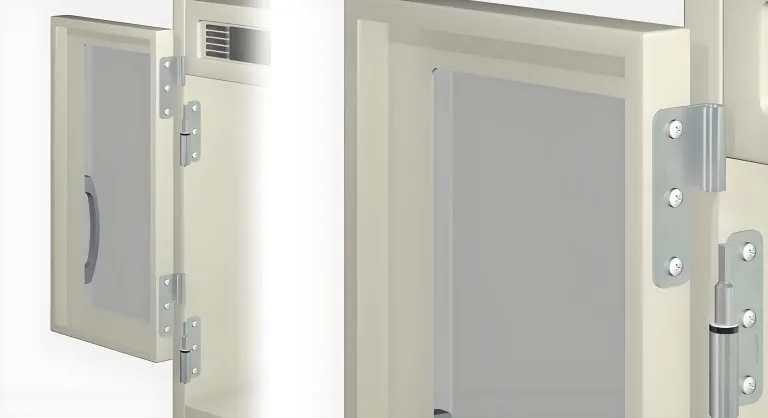Torque Hinges Installation Guide: 7 Steps for Precision and Durability
Addressing Pain Points: More Than Just “Open” and “Close”
Hinge selection and installation directly impact equipment safety and reliability. Common issues include:
- Unexpected rapid closure of covers posing a falling hazard risk;
- Displays or door panels unable to hold any angle, requiring additional support;
- Requiring gas springs or support rods, increasing costs and structural complexity.
The Solution: Torque hinges (also known as friction hinges) utilize constant friction to hold doors or covers securely at any angle. Their built-in friction mechanism generates resistance during rotation, preventing unnecessary movement. However, even the highest-quality torque hinge will fail if improperly installed. This guide therefore provides comprehensive coverage from torque calculation and hinge selection to installation details, offering engineers a one-stop technical reference.
What is a Torque Hinge? Controlled Friction Principle

A torque hinge is an arbitrary stop hinge that secures doors or covers at any angle. Its internal structure typically includes friction pads, spring clips, grease, and other components. Resistance is generated through the friction mechanism on the shaft, thereby controlling movement. Torque is essentially the force effect that causes an object to rotate around a pivot point, expressed as M=F×dM = F \times dM=F×d. In torque hinge applications, this torque represents the force required to maintain the cover at a specific angle.
Distinguishing Torque Hinge Types

Diagram of one-way vs dual-torque vs adjustable torque hinges
- Constant Torque vs. Brake Torque: Constant torque hinges provide continuous resistance, while brake torque hinges incorporate a mechanical brake at the closing point to eliminate bounce and ensure complete door closure.
- Unidirectional vs. Bidirectional: Unidirectional torque hinges generate torque in only one direction (typically the lift direction); friction in the opposite direction is minimal, making door closure easier. Bidirectional torque hinges provide torque in both opening and closing directions, with torque values typically similar in both directions (some products differ by approximately 30%).
- Fixed Torque vs. Adjustable Torque: Fixed torque hinges have a factory-set torque value that cannot be altered; adjustable torque hinges incorporate an internal adjustment screw, allowing fine-tuning of the required torque with a hex wrench to adapt flexibly to different door panel weights or usage habits.
The Foundation Before Installation: How to Accurately Calculate Required Torque
Why “Weight” is Misleading, and “Torque” is Key
Hinges bear the torque required to hold the door panel at a specific angle, not merely its weight. Torque M=F×dM = F \times dM=F×d (Newton-meters), where FFF is force (including gravity) and ddd is the lever arm distance. For example, greater door panel weight or a center of gravity farther from the hinge axis increases the required torque. If the rated torque of the selected hinge is lower than the actual torque of the door panel, the door will not stay open and will “swing open” or fall off during use.
Detailed Steps for Calculating Torque
Determine the door panel weight (W): Measure the door panel’s mass, then multiply by gravitational acceleration (g=9.8 m/s2g = 9.8\,\text{m/s}^2g=9.8m/s2) to obtain gravitational force F=WgF = WgF=Wg (Newtons).
Determine the center of gravity: Locate the mass center of the door panel, typically at the midline of the panel width for uniform sheets.
Measure the horizontal distance (d) from the hinge axis to the center of gravity: This is the horizontal projection distance from the hinge pivot point to the mass center.
For top-opening covers (horizontal mounting axis): Maximum torque occurs when the door panel is horizontal: M=F×(width/2)M = F \times (width/2)M=F×(width/2). If the cover plate forms an angle θ\thetaθ with the hinge axis, torque is M=F×(width/2)×cosθM = F \times (width/2) \times \cos\thetaM=F×(width/2)×cosθ (maximum occurs when cosθ=1\cos\theta = 1cosθ=1).(Learn more about the torque calculation for top-opening covers, an essential design model in torque hinge engineering.)

Torque calculation diagram of a top-opening lid
For side-opening doors (vertical hinge axis): The door panel experiences torque at any angle, but the most extreme case typically occurs at the half-open position, where the moment required to support the door’s self-weight must be considered. The calculation method for vertical axes differs slightly, requiring consideration of the door panel’s weight distribution across the opening angle.
Adding Safety Margin: The calculated theoretical torque should be increased by approximately 20–25% to account for manufacturing tolerances, wear, and other uncertainties.
Example: For a 5kg cover plate with a width of 400mm, the gravitational force is approximately 5×9.8=49 N5\times9.8=49\,N5×9.8=49N. With the center of gravity on the centerline (d=0.2 md=0.2\,md=0.2m), the calculated torque is M=49×0.2≈9.8 N⋅mM=49\times0.2\approx9.8\,N·mM=49×0.2≈9.8N⋅m. Adding a 25% margin, select hinges rated for approximately 12 N⋅m12\,N·m12N⋅m or higher.
Note: Always consider torque tolerance during selection. Some hinges have torque tolerances as high as ±20%, meaning a hinge rated at 3 N·m may only deliver 2.4 N·m. If the required torque for the door panel approaches this lower limit, reliable hold-open performance cannot be guaranteed.
Relevant Technical Standards Reference
Following industry practice, design and testing processes should reference relevant standards. International standards such as ISO 15653:2018 (General purpose hinges for industrial use) and EN 1935:2020 (Hinges for doors and windows in buildings) specify hinge performance requirements; National standards like GB/T 20666-2006 (General Technical Conditions for Welded Hinges) specify general technical parameters for hinges. These standards can be used for verification and testing to ensure selected hinges meet design requirements.
Select Hinges Based on Application Environment
Material Selection: Corrosion Resistance, Temperature Tolerance, and Cleanliness Requirements
Different environments impose distinct material demands on hinges. Common materials and their characteristics are as follows:
| Material | Characteristics and Applications |
|---|---|
| Stainless Steel (316/304) | High corrosion resistance and strength; 316L offers significantly greater resistance to humid salt spray than 304. Suitable for marine, food processing, medical equipment, outdoor equipment, and similar environments. |
| Zinc Alloy | Moderate cost, relatively high strength; suitable for general indoor cabinets, distribution boxes, etc. Surface can be powder-coated or electroplated to enhance corrosion resistance. |
| Engineering Plastics | Excellent insulation properties, lightweight; used for light loads or applications requiring electrical insulation, such as electronic equipment housings or medical diagnostic instruments. Note temperature resistance and long-term load capacity limitations. |
Proper material selection extends service life and meets safety requirements. For instance, 400-series stainless steel withstands over 500 hours of ASTM B117 salt spray testing without red rust, making it suitable for most harsh environments.
Cycle Life: Opening/Closing Frequency Requirements
A hinge’s cycle life denotes the number of sustained operations under standard opening/closing conditions. Each operation causes fatigue, so select products with high cycle life. Industry experience indicates that standard industrial hinges typically last around 20,000 cycles, while premium products can exceed 50,000 cycles. In high-frequency usage environments, torque hinges with extended lifespans are recommended to prevent reduced holding force due to fatigue failure.
5 Critical Installation Technical Details
Preparation of Mounting Surface
The hinge mounting surface must be sufficiently rigid and level. If the substrate is too soft or uneven, it can cause deformation of the hinge seat, shifting the relative position of friction components and leading to inaccurate torque values or even failure. Therefore, inspect and reinforce the mounting surface beforehand to ensure no significant deflection occurs after tightening the hinge. The area around the mounting holes must also remain straight.
Strict Axis Alignment

Correct vs Incorrect Torque Hinge Installation (Do / Don’t)
Alignment Key Points: The hinge axes must be strictly parallel and on the same horizontal plane. Any misalignment concentrates torque load on a single hinge or its edge, accelerating localized wear and causing uneven friction. As industry guidelines indicate, misaligned screw holes can lead to door panel skewing, poor sealing, rattling, or even water leakage.
Alignment Technique: Use a laser level or long straightedge to verify the reference line. Secure one side of the hinge first, then fine-tune the opposite side to ensure uniform gaps. Utilize the long slot design (if available) for minor adjustments during installation until all hinge axes align consistently. Proper alignment significantly extends hinge lifespan and maintains constant torque performance.
Use Correct Fasteners
Torque hinges endure continuous twisting forces, so fasteners must possess sufficient tensile strength and torque-bearing capacity. Use mechanical screws or hex socket high-strength bolts matching the hinge hole dimensions and installation thickness. In vibrating environments, pair with threadlocker or spring washers to prevent loosening. Avoid under-tightening during installation, as this may deform the hinge base; similarly, avoid over-tightening to prevent damage to the hinge body. Proper tightening ensures long-term stable operation.
Correct Adjustment Method for Adjustable Torque Hinges
For torque hinges with adjustment screws, calibration must be performed under actual load conditions:
- Adjust under load: Set the torque with the door panel or cover plate attached to accurately gauge friction changes. Adjusting without load yields inaccurate results.
- Adjust incrementally: Turn the adjustment screw 1/4 turn at a time, observing torque changes. Increase or decrease torque in the direction indicated by the arrow. If torque is adjusted on one hinge, make the corresponding adjustment on the other hinge to maintain force balance.
- Precautions: Never over-tighten or fully remove the adjustment screw, as this will cause the hinge to lose its friction-holding capability. After adjustment, re-test the door panel movement to ensure it holds at the desired angle under the intended torque.
Do Not Lubricate!
Torque hinges rely on friction to maintain position. Do not apply any lubricants (such as WD-40, grease, etc.) to the pivot point. This “no-lubrication” maintenance instruction is consistent with federal and institutional maintenance standards that prohibit lubrication on friction-based or torque-sensitive mechanisms (see U.S. Bureau of Reclamation FIST Manual and University of Southern Maine Facilities Specifications).Lubrication destroys the friction layer, rendering the hinge incapable of adjusting torque. Routine maintenance requires only keeping the hinge surface clean—dust may be wiped with a dry cloth. If rust or wear appears, replace the hinge instead of attempting to lubricate it. Proper surface treatments (e.g., powder coating, electroplating) enhance corrosion resistance and reduce maintenance requirements.
FAQ
Q1: Door panel won’t stay in any position?
A: Typically caused by insufficient or uneven torque selection. Verify torque calculations are accurate (considering weight and center-of-gravity distance); ensure hinges are perfectly aligned; if hinges are aged, friction pads may be worn out and should be replaced promptly.
Q2: Opening or closing the door panel requires excessive force?
A: This may result from selecting excessive torque or mismatched torque on a single hinge. Also check for installation misalignment, which can cause jamming. Appropriately loosen the adjustment screw to reduce torque, or realign the axis and retest.
Q3: Hinges become “loose” after several months?
A: Increased swing may indicate insufficient cycle life during selection, or fatigue damage to internal springs/friction pads from prolonged use. Installation deviations can accelerate wear. Additionally, severe environmental corrosion may intensify wear in torque hinges due to rust. Solutions include replacing with products offering longer cycle life, inspecting and correcting installation deviations, and selecting corrosion-resistant materials.







